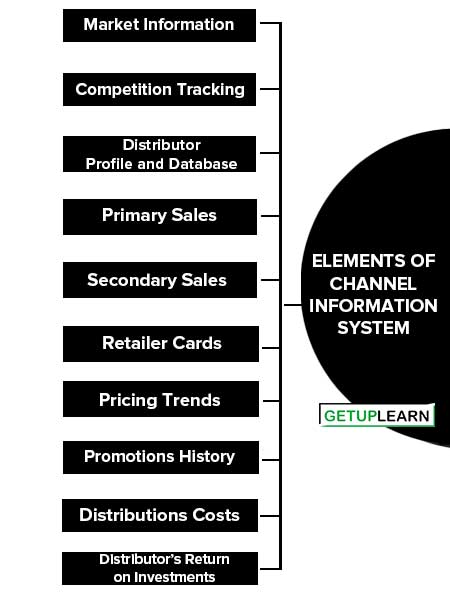The elements of information that the sales managers are interested in are listed below along with their purpose, source of data, action possible, and impact on service.
Table of Contents
Elements of Channel Information System
These are the elements of channel information system:
- Market Information
- Competition Tracking
- Distributor Profile and Database
- Primary Sales
- Secondary Sales
- Retailer Cards
- Pricing Trends
- Promotions History
- Distributions Costs
- Distributor’s Return on Investments

Market Information
This is one of the most important parts of information irrespective of the type of industry for the sales manager. It relates to the market potential, players in the market, competitors’ activities, activities of non-competitors but complementary products, etc.
It has to be accurate, regular, and updated on a regular basis as the market is very dynamic. The channel members should collect and review this information on a regular basis whereas the sales manager needs to do this activity on a weekly basis.
The purpose of collecting market information is to plan the day-to-day activities, and such information is generally collected by the channel partners or the salesperson. It helps to make the necessary changes to the product or pricing as per the market scenario so that timely actions can be taken to maintain the market share.
Competition Tracking
The information regarding competition in the market is the pricing of products, promotions being carried out, new product launches, etc. Such information helps to plan out the operational activities, especially for companies like pharma and FMCG companies.
The main purpose of collecting such information is to keep track of the market competition and is generally collected through salespeople and channel partners.
Distributor Profile and Database
It includes all the information of the distributors such as the name, address, location, name of the partner, name of the contact person, number of years in business, financial strength, etc.
It is generally updated once a year. The main purpose of collecting such information is to plan major events like product launches. The source of information is a salesperson.
Primary Sales
Primary sales mean the sales are done by the company to the distributors. It is easy to collect as all the sales are done from the company to distributors. C&FA are collected and recorded every day.
The purpose of collecting such information is to plan future sales. It helps to avoid situations like stock out as salespeople can pressure distributors to keep adequate stock so that the market does not suffer.
Secondary Sales
Secondary sales mean the sales are done from the distributors to their customers like wholesalers, retailers, institutions, etc. The purpose of collecting such information is to plan promotion activities and to improve sales from the distributor’s point.
The distributors whose movement is slow can be identified and necessary actions can be taken. This information can be collected from salespersons and distributors.
Retailer Cards
These cards are maintained by FMCG and pharmaceutical companies where the number of retail outlets to be covered is large. It consists of information like the name of the outlet, billing amount, size of the packs, average purchase, etc.
It helps to keep a record of the stock holding patterns of retailers. The salesman of the distributors collects the data from the outlets. It helps to plan the potential outlets and focus on promotional activities.
Pricing Trends
The pricing trends of the market need to be traced in order to take corrective actions regarding pricing issues. The data needs to be collected on a daily basis for products having volatile pricing. It helps to take corrective measures regarding pricing and keep updated on whether the company is having any price disadvantage.
Promotions History
The companies keep a record of the promotional history product-wise, the target set and the actual sales achieved, the cost of promotions, and the reaction in the market. It helps in planning future promotions and to assure the effectiveness of promotional events in other markets.
Distributions Costs
The distribution costs need to be recorded in order to optimize the cost of distribution and maximize the productivity of partners by comparing them with other channel partners.
Distributor’s Return on Investments
The Return On Investments (ROI) from the distributors needs to be measured and recorded in order to ensure adequate returns and take necessary corrective measures to improve the ROI.
FAQs About the Elements of Channel Information System
What are the elements of channel information system?
The elements of channel information system are:
1. Market Information
2. Competition Tracking
3. Distributor Profile and Database
4. Primary Sales
5. Secondary Sales
6. Retailer Cards
7. Pricing Trends
8. Promotions History
9. Distributions Costs
10. Distributor’s Return on Investments.
